Presented at the International Women’s Day Conference for Hertfordshire Community Services
Date: Wednesday, 8th March 2017
By Michelle Daley
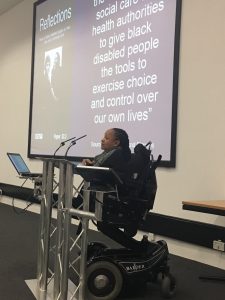
Thank you for inviting me to speak at your International Women’s conference. It is with great privilege that I have been invited to your conference to present on ‘intersectionality and its relevance in social care for Disabled Women’ on a subject so pertinent to my own life.
Before I continue I want to take a moment to ask each of us what International Women’s Day means to you? I think your leaflet summed it up well “to celebrate and value the achievements of women…” but your focus is on social care.
Our History, Women’s History
International Women’s Day gives the world an opportunity to learn about women’s past and present struggle for equality and also for us today the role women played to improving provisions in health and social care. However Disabled Women’s contribution has often gone unrecognised or poorly represented throughout the teachings of history and has provided lessons for society today on how to respond to Disabled Women. The inequality experienced by Disabled Women is highlighted in a report by the Equality and Human Rights Commission (2014) titled ‘Concluding Observations of the Committee on the Elimination of Discrimination against Women. Understanding what governments need to do to advance women’s rights in Great Britain.’ Echoing this point in 2016 the UN rights committee (UN News Centre, 2016) was quoted as saying that “national policies often tend to treat women and girls with disabilities as helpless objects of pity or allow them to be treated in that manner.” (no page numbers).
As I grew in my political consciousness it became clear to me that domination of biased history which we are taught is ablest and favouring dominate members of society. It ignores women’s different intersections and starves us from learning about the contributions all women have made to equality and human rights. So I had to teach myself (mostly procrastinating over the internet to be honest). It gives me great pleasure today to be able to share women’s history which is about us from an unbiased perspective.
This year the theme for International Women’s Day is “#BeBoldForChange” could not be any more symbolic it resonates the advocacy, activism and feminists work from our past, present and future. Here are some examples of Disabled Women’s rights advocates and campaigners:
- For me Sojourner Truth is one of the pioneering women she spoke the unspeakable when she gave one of her most famous speeches and asked "Ain't I a Woman?” in 1851 at the Women’s Rights Convention in Akron, Ohio (Perry, 2005).
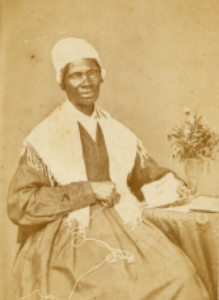
- Rosa May Billinghurst was a suffragette, women’s rights activist and a social worker in a Greenwich workhouse (Sisters of Frida, nd). It is reported that she is best known for her militancy.
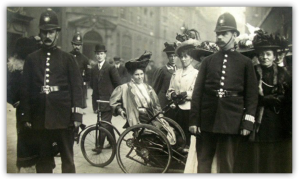
- Helen Keller was also an advocate on women’s rights and disability equality and was quoted as saying "I think the degree of a nation's civilisation may be measured by the degree of enlightenment of its women.” (American Foundation for the Blind, nd).
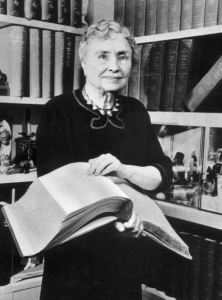
Also in the 1990’s disabled women joined in protests (Rose, 2015) demanding for a change in the law. And again in recent years disabled women take to the streets fighting against discrimination, austerity and so on… (Porter and Reed, 2014).
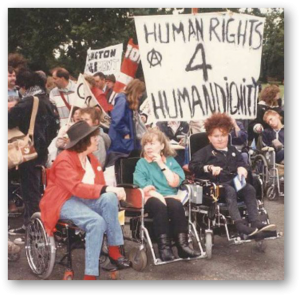
|
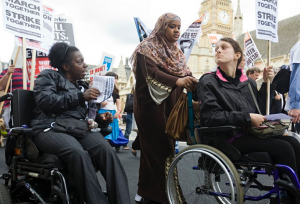
|
Today we have demonstrated that all human beings share a common destiny for equality, justice and human rights.
Intersectionality in social Care
We have already discussed at length the underrepresentation of Disabled Women in women’s history but I’m now keen to explore to what extent intersectionality is considered in social care.
Case study
Angela Blog (30yrs) a married mother of 2 sons (2 & 6yrs). She lives with her partner who is also a Disabled Person they have their own support needs. She lives in an accessible property with her family and works part-time as a qualified accountant. Angela has Cerebral Palsy, uses a powered wheelchair, needs help with transfers and requires support with personal care. Angela is concerned that she is not able to carry out her caring role as a mother. Discuss.
Does an assessment matter and what lesson have we learnt?
For people in need of support the assessment plays a significant role in the process used in social care for gathering information, developing understanding and knowledge about the client’s situation. The assessment of need is also used along with a multitude of other information to make decisions and agree the client’s eligibility and level of support.
I want to now explore how much our personal attitudes and bias influence the assessment outcome? The argument presented by Morris (1993) a prominent Disabled Woman, research and feminist points to the influence of the medical model of disability which she believes dominates the focus of assessment of need.
In another one of Morris (2013) literatures she writes:
“what is wrong is systems to determine eligibility which do not measure disabling barriers, but which instead force people into emphasising how ill or impaired and ‘vulnerable’ they are in order to get support” (no page number).
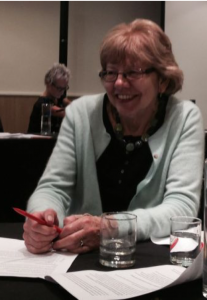
The wider issues for Black Disabled Women is discussed by Nasa Begum, Millie Hill and Andy Stevens (1994) in a book titled Reflections: The views of Black Disabled People on their Lives and Community Care.
They wrote this book with the intention that it:
“will encourage people involved in the services in social care and health authorities to give Black Disabled People the tools to exercise choice and control over our own lives” (p.12).
Nasa Begum (Barnes, 1992) was well recognised for her work on social care and also issues effecting Black Disabled people. She wanted people to understand the different oppressions experienced by Black Disabled people. It was at a seminar on Independent Living and Personal Assistance in 1992 where she was quoted as saying:
“our oppression has been compounded by the fact that we have been encouraged to ignore our blackness. People think that if you just focus on our concerns as Disabled People then all our needs will be met.” (p.51).
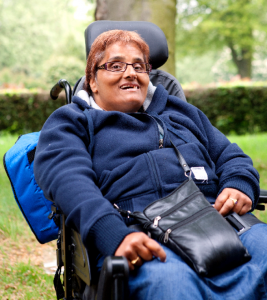
I concur with Nasa Begum (Barnes, 1992) on this point she reinforces the message that Black Disabled People are not a homogenous group. I am a woman, a black woman and a disabled woman. In most areas of my life I'm forced to compartmentalised my different intersections. It was Patricia Hill Collin (2000) that introduced the matrix of domination as way to explain how the different oppression relate and feed off of each other. I relate this point from one of my assessments of need. So when I explained that I needed help with skin care, which is not related to my impairment, it was dismissed. The assessor had no knowledge about skin sensitive and dryness often experienced by Black People and the need for daily skin care to prevent discomfort. In this example it demonstrated how my different intersections as a Black Disabled Woman were not considered and how they interact with each other. This is the point being stressed by Patricia Hill Collin (2000) about the matrix of domination and how the:
“intersecting oppressions are actually organized. Regardless of the particular intersections involved, structural, disciplinary, hegemonic, and interpersonal domains of power reappear across quite different forms of oppression.” (p.18).
I’m forced to create intersectional hierarchy of my different oppressions and decide which intersection is important. It is these issues that Nasa Begum (Barnes, 1992) continued to raise concerns about the experience of Black Disabled People and the invisibility of our different intersections.
In recent years there has been a shift in the way assessments of need are carried out to promote person centred working and also the way services are offered enabling greater choice and control. In doing so Suzy Braye and Michael Preston-Shoot (1995) hope that social care professionals will be encouraged to:
“negotiate the power dynamics of relationship with users” (p.3).
I’m of the view the mere fact that the person carrying out the assessment has a job title; they conduct the assessment of need which is on the behalf of the local authority. It is the same organisation that has the responsibility to make a decision (based on guidelines) to determine the outcome on the assessment. The individual in need of support is not involved in the way the information is presented to the assessment panel where the decisions are made. This clearly contradicts the notion pertaining to shifting of power dynamic between professionals and users (Braye and Preston-Shoot, 1995). The reality of the situation creates unequal dominance whereby advantage position of power and privileged action is placed with the assessor and the decision makers.
Such experiences infuriate Morris (1998) she advocates that:
“As disabled women, we have to find a way of making our experiences visible, sharing them with each other and with non-disabled people, in a way which – while drawing attention to the difficulties in our lives – yet does not undermine our wish to assert our self-worth. (p.5).
To recognise discrimination generated by Disabled Women’s different intersection, European Parliament produced a report to provide an overview about disabled women experiences titled: ‘Discrimination Generated by the Intersection of Gender and Disability (Davaki, Marzo, Narmino and Aranitidou, 2013).
Theory
The social model of disability focus is on individuals’ impairment, demands for inclusion and full participation of disabled people in society (Oliver, 1996). Here’s what Baroness Jane Campbell said (Community Care, 2006):
“the social model was a road to Damascus experience for me because suddenly I could throw off all the guilt and oppression of being a disabled person. I couldn’t change me, I wasn’t going to walk, swallow or give long speeches, but I could do other things in other ways with the help of others. That was total liberation.”
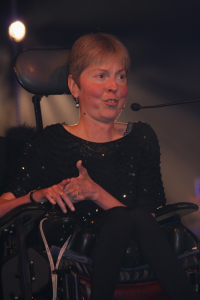
As already mentioned Patricia Hill Collin (2000) introduced the matrix of domination. Kimberele Williams Crenshaw first introduced intersectionality theory (New Statesman, 2014) as way to address gender and race inequality.
In an attempt to address Disabled Women’s oppression and to build on the strength of the social model of disability (Oliver, 1996) and the feminist theory (Freedman, 2001). The term feminist disability theory (Garland-Thomson, 2002) was used to address discrimination generated by the different intersections Disabled Women experience but also how they each interact with each other which is pertinent to subject being discussed today. Angela Davis (no date) reminds us about progress made but says it time for us to:
“…recognize the intersectionality, the interconnectedness of all of these institutions and attitudes.” (no page number).
Summary & Reflection
What have we learnt from today's discussion:
- Not to promote biased dominate history about women which often devalues and perpetuates a Disabled Woman as less of a woman.
- Address Disabled Women's intersectionality and acknowledge the multitude of oppression which can lead to discrimination
- Apply the social model of disability in practice
- Recognise the cause and effect of professional position of power and privilege action
We have learnt and also noted by Morris (1998) that:
“disabled women are – in addition and often more – concerned with having choice and control over the assistance they need to fulfill their caring role within the private world of the family” (p.6).
We have also learnt that intersectionality in social care for Disabled Women is relevant because it allows us to understand the needs of Disabled Women. It can also help us understand “intersectional discrimination” and thus provide “better protection” of Disabled Women. (Davaki,K, Marzo, C, Narmino, E and Aranitidou, M, 2013, p.10).
Conclude
And finally I want to close with words from Kimberele Williams when she says that "if we aren't intersectional, some of us, the most vulnerable, are going to fall through the cracks” (Feminist.com, 1995 – 2004, no page number) which forces us to think about and recognise the importance of adopting intersectionality in practice.
Happy International Women's Day and Thank You
Reference
- American Foundation for the Blind (nd). Helen Keller Quotations.
- Barnes, C (ed) (1992). MAKING OUR OWN CHOICES. Independent Living, Personal Assistance And Disabled People. BCODP Seminar on Independent Living and Personal Assistance.
- Begum, N, Hill, M and Stevens, A (1994) Reflections. The views of Black Disabled People on their Lives and Community Care. Central Council for Education and Training in Social Work. London
- Braye, S and Preston-Shoot, M (1995). Empowering Practice in Social Care. Open University Press. England
- Collin, P H (2000). (2 edition) Black Feminist Thought. Knowledge, Consciousness, and the Politics of Empowerment. Routledge. London
- Community Care (2006). Life is Beautiful.
- Davaki,K, Marzo, C, Narmino, E and Aranitidou, M (2013). Discrimination Generated by the Intersection of Gender and Disability. European Parliament. Brussels.
- Davis, A (no date). AZ Quotes.
- Equality and Human Rights Commission (2014). Concluding Observations of the Committee on the Elimination of Discrimination against Women. Understanding what governments need to do to advance women’s rights in Great Britain.
- Feminist.com (1995 – 2004) Kimberly Williams Crenshaw.
- Freedman, J (2001). Concepts in Social Science Feminism. Open University Press. Buckinghamshire.
- Garland-Thomson, R (2002). Integrating Disability, Transforming Feminist Theory. Source: NWSA Journal, Vol. 14, No. 3, Feminist Disability Studies (Autumn, 2002), pp. 1-32.
- Morris, J (2013). Welfare reform and the social model of disability.
- Morris, J (1998) Feminism, gender and disability.
- Morris, J (1993). Independent Lives? Community Care and Disabled People. The MacMillan Press. London
- New Statesman (2014). Kimberlé Crenshaw on intersectionality: “I wanted to come up with an everyday metaphor that anyone could use”
- Oliver, M (1996). Understanding Disability from Theory to Practice. MacMillan Press. London
- Perry, I (2005). Narrative of Sojourner Truth. Barnes & Noble. New York
- Porter, J and Reed, H (2014). Austerity has hit women, ethnic minorities and the disabled most.
- Rose, D (2015). When disabled people took to the streets to change the law.
- Sisters of Frida (nd) Rosa May Billinghurst, disabled woman suffragette.
- The UN News Centre (2016). Women and girls with disabilities are equal rights holders, not ‘helpless objects of pity’ – UN rights committee.

While accepting that intersectionality needs refining as a tool, a majority of social commentators and mainstream feminist and racial justice groups believe intersectionality does have an important role to play in today s civil rights movements.